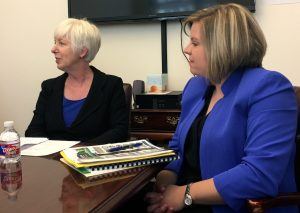Arkansas foster care system ‘in a crisis’; steps taken to fix
by November 14, 2016 6:18 pm 984 views

The state’s foster care system “truly is in a crisis” as the number of placed children has grown nearly 30% the past year – partly because a lack of experienced caseworkers is slowing the movement of children out of the system, said Department of Human Services Director Cindy Gillespie.
Gillespie made the comments Monday (Nov. 14) as the department released a report, “Moving Beyond Crisis,” which she said outlines a “phase 1 stabilization plan.”
The number of children in the system has increased from 4,000 in 2013 to 5,200 today. More children are entering the system, though not in unprecedented numbers, and fewer are leaving it to be reunified with their families. Meanwhile, the number of child maltreatment investigations has increased a relatively small 5.8% in the last year.
The slowdown in family reunifications has been caused by a variety of factors, including a drop of caseworkers by about 100 since 2010. The remaining 938 caseworkers have less time to focus on families’ needs for reunification, said Gillespie and Mischa Martin, director of the Division of Children and Family Services, which manages the foster care program.
Starting the first week of May and lasting four months, DHS’ leadership team met three times a week for one to two hours in what Gillespie called a “war room.” Gillespie said DCFS through the years had become a standalone division when in fact the problems that lead to foster care require acton by all of DHS’ various divisions.
“There is no ‘the problem.’ … This is a situation where we have a lot of things that are happening, and all of these various elements and issues have to be addressed over months if we’re going to begin to stabilize the program,” Gillespie said.

Martin and Gillespie said case workers are overworked, understaffed and underpaid. They average 28 cases per worker when the national standard is 15 and are working so much overtime that burnout is a problem. With average salaries of $31,000, they accomplish important tasks like finding homes for children. But a time study determined they also were spending long hours driving and making copies. Most areas of the state have a turnover rate of 32%, with the average field staff experience dropping so that most have an average of 1.8 years of experience. Some are taking lower salaries to work in another DHS office.
Gov. Asa Hutchinson has proposed $26 million in fiscal year 2018 and $11 million in fiscal year 2019 to fund 228 additional staff members, including 150 new caseworkers. The agency seeks to increase salaries and is considering other changes such as a second shift to allow workers more time off, hiring program assistants to handle clerical work, and creating a mobile crisis team. Based on a suggestion by the department’s IT director, caseworkers will alert foster families of a prospective child placement via group text before they begin calling homes one at a time, a time-consuming process.
Martin said the slowdown in family reunifications cannot be blamed on changes in the nature of families entering the system, or on the children. Fifty-two percent of children who entered the system in Arkansas last year did so because of parental substance abuse issues.
Meanwhile the governor has recommended $4.1 million in rainy day funds from now through June 2017 for a prevention and reunification unit tasked with helping children remain in their homes. Paraprofessionals would visit struggling families multiple times a week to offer training and referrals. The funds must be approved by the Legislature.
Meanwhile, $2.5 million in federal CMS funds will provide therapy and transitional services through Medicaid for “stuck” children – those who have serious mental health issues who are in institutions but whose institutionalization is no longer considered medically necessary. Remaining in that kind of care has proven to be bad for children and expensive for the state, which must pay the entire cost once their care is considered medically unnecessary.
DCFS has set a goal of increasing the number of foster homes from the current 1,641, along with 274 therapeutic homes, to 1,749 by August 2017 along with 350 therapeutic homes. Another goal is increasing the percentage of children placed in their home counties from the current 46% to 55% by August 2017, and increasing the percentage afterwards.
It also is working to increase the percentage of children placed with relatives or someone close to the child from the current 25.1% to the 29% national average. In May when the war room was formed, the percentage was 21.3%. Martin said the division is trying to remove barriers to placement with relatives. Meanwhile, DCFS has set a goal of having no children under age 10 in emergency shelters and other types of group care.
